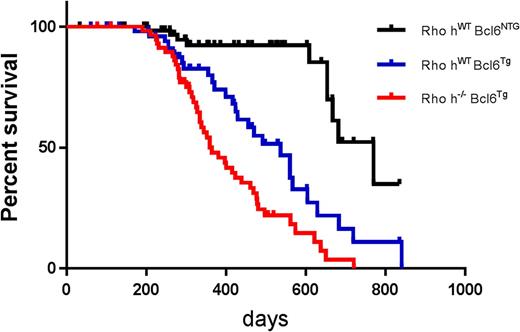Abstract
Diffuse large B cell lymphoma (DLBCL) is an aggressive malignancy of mature B lymphocytes, accounting for 30%-40% of cases of non-Hodgkin's lymphoma. DLBCL has been classified by gene expression profiling into three subtypes GC-B-cell like (GCB)-DLBCL, activated B-cell like (ABC)-DLBCL and primary mediastinal B cell lymphoma (PMBL) or by immunohistological analysis into two subtypes, GCB-DLBCL and non-GCB- DLBCL. Rho H, a hematopoietic-specific Rho GTPase is required for CD3-zeta phosphorylation and recruitment of the protein tyrosine kinases Zap70 and Lck to the cellular membrane and immunologic synapse (Gu et al. Nat Immunol. 2006). Therefore, Rho H deficient (Rhoh-/-) mice exhibit T-cell deficiency due to impaired T-cell receptor-mediated selection and maturation of thymocytes. RHOH was first identified as a hypermutable gene and translocation partner in human B cell malignancies (Dallery E, et al . Oncogene. 1995) and RHOH mutations have been reported in 35 of 100 DLBCL cases (Hiraga J, et al. Leukemia. 2007). However, the effect of RHOH mutations and translocations on RHOH expression and the biology of lymphoma are completely unknown.We crossed Rhoh-/- and the DLBCL mouse model Iµ-HABcl-6 transgenic mouse (Cattoretti G, et al. Cancer Cell. 2005) to generate Rhoh-/- ;Bcl-6Tg and RhohWT;Bcl-6Tg mouse, and compared outcomes of these groups. Rhoh-/-; Bcl-6Tg mice developed severe splenomegaly and succumbed to disease more quickly compared with RhohWT; Bcl-6Tg mice (Figure1, Log-rank test p<0.01). Histological examination showed loss of splenic architecture and invasion of large, heterogenous lymphoid cells resembling human DLBCL. In contrast to RhohWT; Bcl-6Tg mice immunohistochemistry showed that RhohKO lymphoma cells were uniformly and strongly positive for IRF4 suggesting that loss of Rho H alters the phenotype of lymphoma at the cellular level to a ABC-DLBCL-like phenotype. Moreover, the number of Ki-67 positive cells showed a 2.5-fold increase in the spleens of Rhoh-/- lymphoma mice compared to RhohWT lymphoma mice (p<0.05). Cleaved Caspase-3, an indicator of apoptosis, was not significantly different between Rhoh-/- and RhohWT lymphoma cells. Western blot analysis of lymphoma cells showed that expression of BCL-6 was consistently increased in Rhoh-/- lymphoma cells compared with RhohWT lymphoma cells while expression of RelA/p65, NF-κB subunit, was upregulated in nuclear fraction of both Rhoh-/- and RhohWT lymphoma cells. Finally, expression of BLIMP-1, a key transcription factor associated with differentiation of B cells into plasma cells, was downregulated in Rhoh-/- lymphoma cells. We conclude that deletion of Rhoh in BCL6-driven DLBCL leads to ABC-DLBCL-like phenotype in this model of lymphoma associated with increased proliferation and more rapid progression of disease. These results support a role for Rho H mutations in the development of diffuse large B cell lymphoma.
No relevant conflicts of interest to declare.
Author notes
Asterisk with author names denotes non-ASH members.


This feature is available to Subscribers Only
Sign In or Create an Account Close Modal